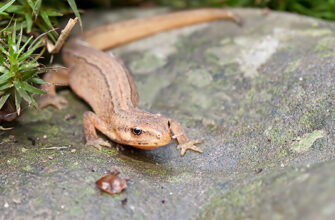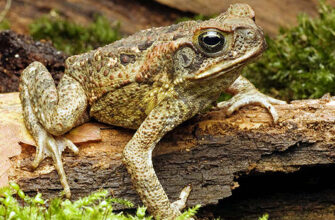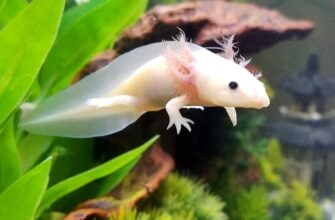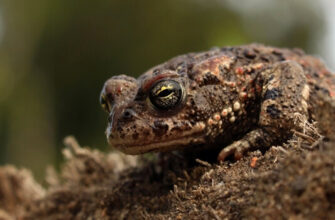The goliath frog with its appearance causes some numbness, indeed, the frog princess, just like from a fairy tale. The huge size of this amazing amphibian is simply amazing. We will try to consider all the most fascinating, describing not only the appearance of the gigantic frog, but also its temperament, behavioral features, favorite places of settlement, breeding nuances and information about the size of its population, not forgetting to mention a number of interesting facts about this unusual animal.
View origin and description
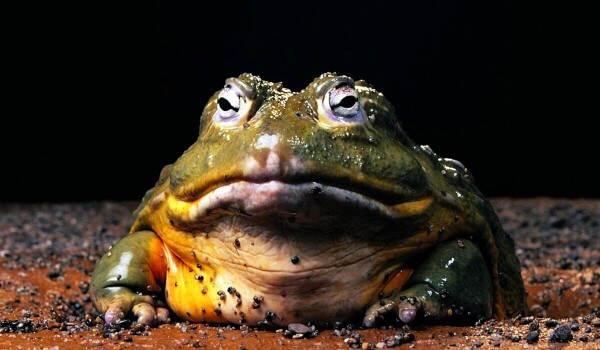
Photo : Goliath Frog
The goliath frog belongs to the order of tailless amphibians, belongs to the family of real frogs. The external parameters and dimensions of the representatives of this family group are different. In most cases, almost all members of the family of true frogs tend to have moist and smooth skin. Scientists identify 395 varieties and as many as 26 genera in this family.
It is not for nothing that this frog is named after the biblical hero, the huge Philistine warrior Goliath (2.77 m tall), because in terms of its dimensions this amphibian ranks first place of honor throughout the world space, being the largest frog on our planet. The indigenous population of the places where the frog settled affectionately called it “nia-moa”, which translates as “son”.
Video: Goliath Frog
This frog became known relatively recently. Its pioneers are European zoologists who discovered such a heroic creature only in 1906. Many people have a question: “How could you not notice such a huge frog earlier?!”. Perhaps the answer lies in the frog character, which, despite its solid size, is very shy, incredibly cautious and very secretive.
In this regard, this amphibian has been studied very little, many of the nuances of its life are a mystery to us and to this day. It is worth adding that although the goliath frog has a solid size, in appearance it is very similar to its smaller relatives.
Appearance and features
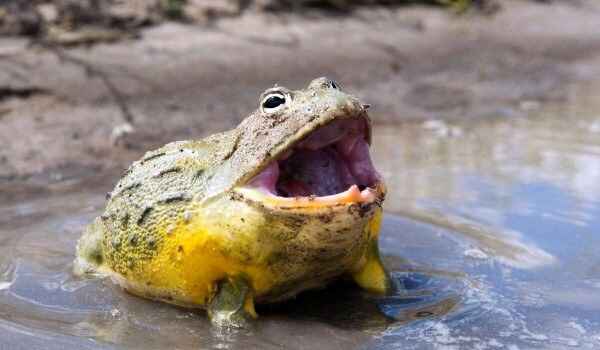
Photo: Great Goliath
It is simply amazing that the length of the frog’s oval body is about 32 cm (this is without taking into account the huge paws), on average, the mass of giant frogs varies from 3 to 3.5 kg, but there are specimens that are much more impressive, the weight of which can reach 6 kg, which is just amazing. Looking at the photographs of children holding a goliath frog in their hands, you are very surprised at the huge size of these amphibians.
Interesting fact: If you measure the length of the goliath frog, along with its extended and powerful limbs, then it will be all 90 cm or even a little more.
Regarding their appearance, goliaths are quite identical to other frogs (if you do not pay attention to their dimensions). The predominant frog skin color is dark green, where some brownish blotches (shine) are visible.
The abdomen, chin and inside of the legs have a lighter tone, which can be:
- dirty white;
- beige;
- brownish yellow;
- greenish yellow.
The dorsal region of the frogs is wrinkled, various tubercles are visible on it. The frog’s eyes are quite large, have a yellow-golden iris and horizontally arranged pupils, and are protruding, which is characteristic of all frogs. The hind limbs are very impressive and long, their length can reach up to 60 cm, which is almost twice the length of the entire frog body. The toes are also large and oblong, they are connected by membranes (on the hind legs).
An interesting fact: Africans and French gourmets are on a real hunt for large and fleshy goliath legs, which are classified as delicacies. All this has a very detrimental effect on the number of frogs.
As for sexual dimorphism, these frogs have it: males look more miniature, and the body length of females is much longer. Just imagine that a goliath frog can make a giant three-meter jump!
Where does the goliath frog live?
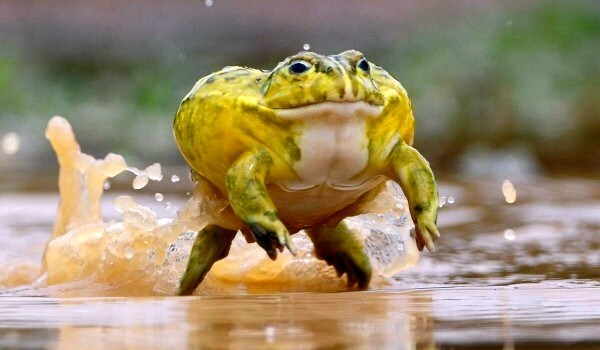
Photo: African Goliath
We are accustomed to thinking that swamps are preferable for frogs, they are not too picky and picky about their places of settlement and can live peacefully and happily in polluted water bodies, choosing even simple puddles. All this has absolutely nothing to do with the Goliath frog, it very carefully and scrupulously chooses the places of its permanent deployment, responsibly approaching this most important procedure, on which its future life frog well-being depends. Goliaths like only those water spaces where the water is crystal clear, has a certain temperature and is rich in oxygen.
Giant frogs take a fancy to running waters, adoring tropical waterfalls, fast-flowing rivers. Of great importance when choosing a place of residence is the temperature water regime, which should be kept in the range from 17 to 23 degrees with a plus sign. The presence of high humidity (up to 90 percent) is also favorable for the life of this species of amphibians. Goliath frogs spend most of their daytime sitting on rocky ledges that are constantly sprayed by waterfalls and raging fast-flowing river systems.
As for the specific habitats of these frogs, these large-sized individuals are residents of hot African content , occupying a very small territory on it.
Goliaths inhabit:
- Equatorial Guinea (especially the Gulf of Guinea);
- southwestern Cameroon;
- Gabon (scientists have an idea that these frogs live here, but it has not yet been confirmed).
What does the goliath frog eat?
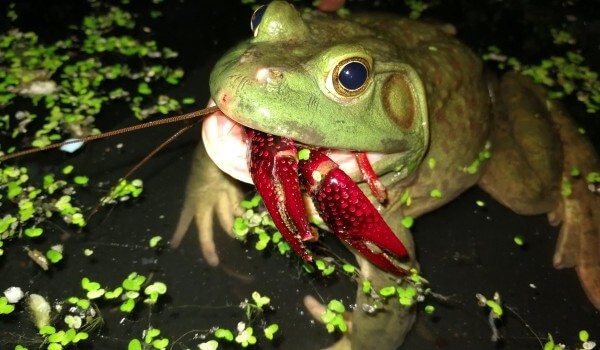
Photo: Giant Goliath Frog
Since the goliath is very large, he needs a lot of food, because he has a heroic appetite. Hunting takes place mainly at dusk, apparently for security purposes. Frogs seek out their prey both on land and in water. Invertebrates and all kinds of insects are the predominant dishes on the menu.
So, goliaths will not refuse:
- larvae;
- spiders;
- crustaceans;
- worms;
- locusts;
- cockroaches;
- grasshoppers.
In addition to all of the above, the frog menu contains other medium-sized amphibians, fish, scorpions, small rodents, lizards, small birds (or chicks) and even snakes. Goliaths have their own hunting tactics: having seen a bite, the frog in a swift jump (it can reach three meters in length) overtakes the prey. When jumping, massive frogs press down the prey, stunning it. Then the goliath immediately proceeds to the meal, grabbing a snack, squeezing it with powerful jaws and swallowing it whole, which is typical of a frog breed.
Small insects, like other frogs, goliaths grab with their tongues, swallowing them with lightning speed. It should be added that many victims do not even see a frog in their field of vision. This is because the goliath is able to attack from afar, possessing incredible vigilance, and is very well camouflaged, completely merging with rocky ledges located above the water.
Peculiarities of character and lifestyle
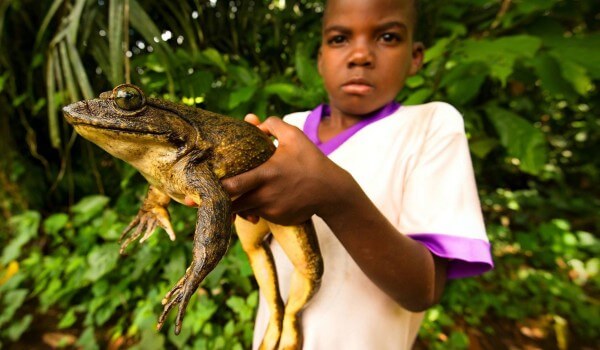
Photo : Goliath Frog
Goliath frogs are used to being cautious, they are always on the alert, for all their large size they have a rather calm and shy character. When choosing a place on the rocks for a daytime rest, amphibians, first of all, make sure that the view of the surroundings is unhindered, so they will immediately notice the ill-wisher and be saved. I must say that the hearing of frogs is simply excellent, and their vigilance can be envied, they are able to see a moving enemy or prey at a distance of 40 meters.
Catching a goliath is not an easy task. Sensing the slightest danger, he instantly dives into the water, hiding in a seething raging stream, where he is able to arrive from 10 to 15 minutes. When all the unpleasant is left behind, the tip of the frog’s nose and a pair of bulging eyes first come to the surface of the reservoir, and then the whole body appears. The frog moves in the water with the help of intermittent shocks, and on land – by jumping. These amphibians are quite strong, because. easily overcome swift and turbulent currents.
In general, it is very difficult to study the life activity of these gigantic amphibians, they lead a very quiet and inconspicuous existence. Having taken a fancy to some rock ledge that forms a waterfall, the goliath can sit on it for a long time without a single movement, as he usually does during the day, and at night he searches for food. Frogs don’t slip off wet rocks. their front paws are equipped with special suction cups, and there are membranes on their hind legs. All these devices add to their stability, or rather, perseverance.
Interesting fact: The goliath frog is literally very quiet, because. makes no sound at all. The quiet goliath does not have the special vocal resonators that its relatives have, so you will not hear it croak.
Social structure and reproduction
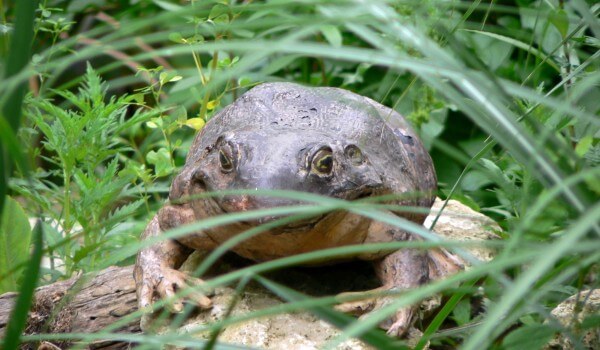
Photo: Big Goliath Frog
Scientists believe that goliath frogs are territorial creatures, i.e. each frog individual has its own home area, occupying about 20 square meters. There she is constantly deployed and hunts. Goliath frogs start breeding during the dry season. So far, it has not been possible to find out how silent gentlemen call young ladies to themselves. Scientists know only that the process of fertilization is carried out in water.
A female can reproduce up to 10 thousand eggs (eggs) with a diameter of at least 5 mm during one season. Caviar laid in lumps is attracted to the bottom of streams. It is not known exactly about the incubation period, but according to some sources, they are about 70 days. The length of each born tadpole reaches approximately 8 mm, their mouth is equipped with suction cups on the sides, with the help of which the babies are attached to the stone underwater ledges. With a strong and muscular tail, they can withstand fast currents. Tadpoles feed on aquatic vegetation.
The process of transformation into frogs occurs when the tadpoles reach 5 cm in length, then they lose their tail. Without a tail, small frogs have a length of 3.5 cm. Goliaths become sexually mature when the length of their body reaches 18 cm in length. The average lifespan of a frog is about 15 years.
Interesting fact: There is recorded evidence that the maximum life expectancy of a goliath frog was 21 years. This is, of course, an exclusive case, but a very impressive one.
Natural enemies of goliath frogs
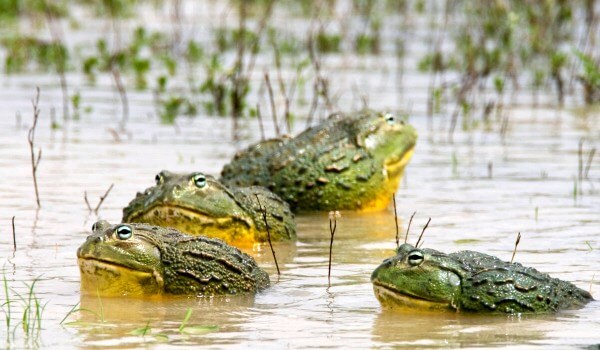
Photo: Goliath frog in water
Although the goliath frog is a giant among its relatives, you cannot call it bold and courageous. She is very shy, has a meek disposition. Among her enemies in their natural habitat are crocodiles, they are not averse to eating such large fleshy amphibians. Sometimes large raptors attack goliaths from the air, but catching this frog is not an easy task. Goliaths are damn careful, very attentive.
The frogs lead a secretive quiet life, skillfully disguising themselves on rocky water ledges. From afar, the goliath can feel and see danger, thanks to its sharp hearing and excellent vision. A frog can distinguish its enemy from a distance of forty meters, which often saves her life, because she immediately hides under water.
The most dangerous, bloodthirsty and insatiable frog enemy is a man, because of which the number of goliaths is sharply declining. The indigenous African population is hunting for these amphibians, because. their meat is considered a delicious delicacy. They kill frogs with poisoned arrows, spread nets and hunting rifles. Not only Africans eat frog meat, there are many gourmets around the world who are willing to pay huge sums in order to taste this delicacy. Frogs are caught not only for gastronomic purposes, they are bought by collectors of exotic animals for captivity.
All this is very sad, because the mighty goliath suffers precisely because of its size, which so attracts and intrigues people. Due to its large size, it is more difficult for a frog to hide, it is not as dexterous as its small counterparts. Making huge jumps, goliaths quickly get tired, run out of steam and risk being caught.
Population and species status
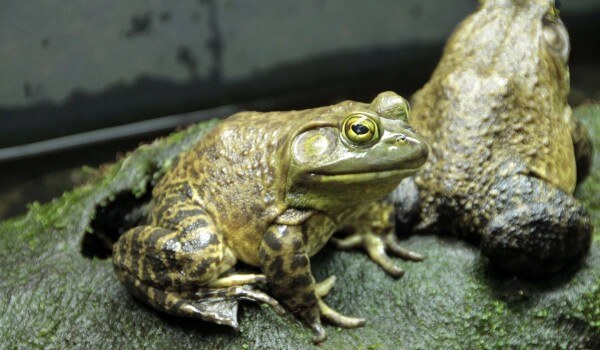
Photo: African Goliath Frog
No matter how bitter it is to realize, but the population of the gigantic frog is very depressing, every year there are fewer and fewer of these amazing creatures. The reason for everything is the selfish and unprecedented interest of people in these unusual amphibians, which attract attention because of their huge height and weight by frog standards.
Interesting fact: There are disappointing statistics about that, from the 1980s to the present day, the number of goliath frogs has halved, which cannot but be alarming.
Human impact on goliaths goes both directly (poaching, trapping) and indirectly (human economic activity). Africans eat these frogs, hunt them for the purpose of selling them to gourmets and restaurants in other countries, who pay them fabulous money for this. Exotic lovers catch goliaths for fun, in order to replenish their private collections with such unusual animals, where, in most cases, frogs die, because. maintaining them is very difficult and costly.
Any zoo strives to get this frog into its property in order to surprise visitors. People do not think about the fact that these meek creatures are very demanding on the places of their settlement, therefore, in captivity, most often they die. A lot of goliath frogs were taken to the United States, where the Americans held frog jumping competitions, destroying many of these amphibians.
People invade natural biotopes, cut down tropical forests, pollute river waters, so there are fewer and fewer places where the goliath frog can freely and happily exist, because it lives only in the purest water with a high oxygen content. Due to the rapid agricultural activity, people are displacing many animals from their usual places of deployment, this also applies to the goliath, the area of u200bu200bsettlement of which is already very microscopic. Based on all of the above, only one conclusion suggests itself – the goliath frog needs certain protective measures in order not to completely disappear from the Earth.
Goliath frog protection
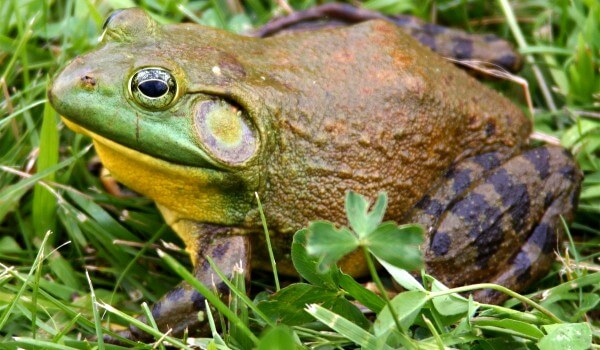
Photo: Goliath frog from the Red Book
So, we have already found out that the number of goliaths is very small, as well as the area of u200bu200btheir permanent settlement. Security organizations are sounding the alarm, trying to save this unusual amphibian, suffering because of its impressive size. According to the IUCN, the goliath frog is classified as an endangered animal species, it is listed in the International Red Book. One of the protective measures is the introduction of a ban on hunting, but poaching is flourishing, it is not possible to eradicate it, people continue to illegally kill and catch giant frogs for profit, caring only for their own personal gain.
Scientists tried to save the species to breed goliaths in captivity, but all this was to no avail. Security organizations are conducting propaganda activities, urging people to be more reverent and caring about these giant frogs, because they are defenseless and so weak in front of bipeds.
The following protective measures were taken by the World Wide Fund for Nature to save goliaths:
- the creation of three reserves, where all conditions have been created for heroic frogs so that they are calm and happy;
- protection of natural places of permanent deployment of goliaths, establishing control over some large river basins.
If all these measures continue in the future, scientists and other concerned people believe that it is likely that this endangered frog species will be saved, and its population will gradually increase. The main thing is that people think and help.
In conclusion, I would like to add that the goliath frog is truly amazing and exclusive. It combines heroic power and an incredibly meek and shy disposition, impressive, solid dimensions and a quiet, calm character, a huge range of strong jumps and sluggishness, a certain slowness. For all its gigantic size, this amphibian is harmless and defenseless, so we need to protect it from any negative and harmful influences. It is worth hurrying, thinking now, otherwise time will be irretrievably lost.

